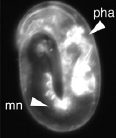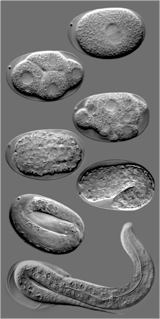Neurobiology

SDN-1::GFP is broadly expressed in the three-fold embryo, and is particularly strong in the pharynx (pha) and the motoneurons (mn) of the ventral nerve cord.
During nervous system development, axons that grow out simultaneously in the same extracellular environment are often sorted to different target destinations. As there is only a restricted set of guidance cues known, regulatory mechanisms are likely to play a crucial role in controlling cell migration and axonal pathfinding. Heparan sulfate proteoglycans (HSPGs) carry long chains of differentially modified sugar residues that have been proposed to encode specific information for nervous system development. Here, we show that the cell surface proteoglycan syndecan SDN-1 functions autonomously in neurons to control the neural migration and guidance choices of outgrowing axons. Epistasis analysis suggests that heparan sulfate (HS) attached to SDN-1 can regulate guidance signaling by the Slit/Robo pathway. Furthermore, SDN-1 acts in parallel with other HSPG core proteins whose HS side chains are modified by the C5-epimerase HSE-5, and/or the 2O-sulfotransferase HST-2, depending on the cellular context. Taken together, our experiments show that distinct HS modification patterns on SDN-1 are involved in regulating axon guidance and cell migration in C. elegans.
Gysi S, Rhiner C, Flibotte S, Moerman DG, Hengartner MO.A network of HSPG core proteins and HS modifying enzymes regulates netrin-dependent guidance of D-type motor neurons in Caenorhabditis elegans. PLoS One. 2013 Sep 16;8(9):e74908.
Rhiner C, Gysi S, Froehli E, Hengartner MO, Hajnal A: Syndecan regulates cell migration and axon guidance in C. elegans. Development 2005, 132:4621-4633.
